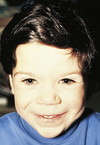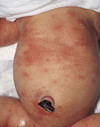Derm/Pictures Flashcards
(40 cards)
1
Q

A
PYOGENIC GRANULOMA
- Common benign vascular tumors that resemble small hemangiomas
- Usually face or extremity
- Solitary bright red, soft nodules, often peduncultaed
- Surface is friable and bleeds easily
- Onset well after newborn period (vs. hemangioma)
- Tx: shave excision and electrodessication of “feeder” blood vessels at the base.
2
Q

A
NUMMULAR ECZEMA
- Acute papulovesicular eruption
- Coin-shaped configuration
- Red scaly patches
- Usually on extensor thighs or abdomen of children with atopic dermatitis
- Lack of central clearing to distinguish from ringworm
3
Q

A
ECZEMA HERPETICUM
- Particularly severe form of primary HSV infection in pts with atopic eczema and/or chronic dermatitis
- Onset of high fever, irritability, and discomfort
- Lesions in crops on areas of recently affected skin
- Evolve to form pustules that rupture and form crusts
- Can become hemorrhagic (to distinguish from chicken pox)
- Tx: acyclovir
4
Q

A
ERYTHEMA CHRONICUM MIGRANS
- Distinctive exanthem of Lyme disease
- Appears in 50% of cases of LYme
- Begins as red papule or macule at site of tick bit that enlarges (up to 15cm) forming large plaque
- Tends to clear centrally
- Multiple secondary smaller lesions can develop in 25% of patients
- Accompanied by flu-like symptoms
5
Q

A
ERYTHEMA MARGINATUM
- Evanescent, nonpruritic, sharp serpiginous margins
- Found on inner aspects of upper arms and thighs and on trunk
- Not specific to acute rheumatic fever
6
Q

A
KLIPPEL-TRENAUNEY-WEBER SYNDROME
- Port-wine stain that usually located over lateral aspect of one leg
- Surface lesion is associated with underlying vascular malformation (rich blood supply) that leads to soft tissue and bone hypertrophy (hemihypertrophy)
- Progressive enlargement during the first few years
- MRI/MRV to evaluate extent of venous/lymphatic malformation
- Complications: DVT, PE, GI bleed, vascular blebs within capillary malformation
- (This picture is atypical b/c bilateral)
7
Q

A
SPRENGEL DEFORMITY
- Congenital malformation with abnormally small, high-riding scapula
- Usually unilateral
- Associated with Klippel-Feil syndrome
- Scoliosis and torticollis
- Shoulder motion severely limited, especially abduction
8
Q

A
KLIPPEL-FEIL SYNDROME
- Congenital malformation of the neck that results from failure of segmentation in the developing cervical spine
- Leads to fused vertebrae
- Short, broad neck with webbing
- Low hairline
- Gross restriction of motion
- Associated with Sprengel deformity, rib deformities, scoliosis, CNS defects, and cardiopulmonary and renal anomalies
9
Q

A
IMPERFORATE HYMEN WITH HEMATOCOLPOS
- Thick imperforate membrane located inside the hymenal ring
- May become evident by 8 to 12 weeks of age
- Can also develop in late puberty (think well-developed secondary sex characteristics but no menstrual periods)
- Tx: incision of membrane to allow drainage then excision of redundant tissue
10
Q

A
VENTRICULAR TACHYCARDIA
- Regular, wide-complex tachycardia with AV dissociation if p waves visible
- Usually children with open-heart surgical repair for TOF or other complex anomalies, cardiomyopathy, myocarditis, or congenital ion channel abnormality (long QT, Brugada) or myocardial tumor
- Prolonged QTc can lead to Vtach
11
Q

A
PERIRECTAL STREP
- Can dx with rapid testing for strep from perineal tissues
- Perineal burning and dysuria
- Sharply circumscribed area of intense erythema
- Involved skin may weep serous fluid
- Desquamation occurs with recorvery
- Tx: penicillin (or amox)
12
Q

A
HURLER SYNDROME
- Mucopolysaccharidoses (MPS I) = lysosomal storage disease
- Onset 6-24 months
- Growth retardation, coarse facial features, hepatosplenomegaly, dysostosis multiplex, cardiac valve disease
- Tx: BMT
13
Q

A
WILLIAMS SYNDROME
- 7q microdeletion (autosomal dominant)
- Characteristic “elfin” facies: broad maxilla, small mandible with full mouth and large upper lip (philtrum)
- Upturned nose
- Full forehead
- Associated with hypercalcemia
- Strikingly affabe personality
- Varying degrees of developmental delay
- Supravalvular aortic stenosis and pulmonary artery branch stenosis
14
Q

A
TRANSIENT NEONATAL PUSTULAR MELANOSIS
- Self-limited dermatosis
- Presents at birth with 1- to 2-mm vesiculopustules or ruptured pustules that disappear in 24-48 hours, leaving pigmented macules with a collarete of scale
- Usually neck, forehead, lower back, and legs
- Wright stain: numerous neutrophils
- NO THERAPY
15
Q

A
ERYTHEMA TOXICUM
- Benign, self limited
- Occurs in 50% of full-term infants
- Appears within 24-48 hours of birth
- Intense erythema with central papule or pustule that resembles flea bite
- Pustules contain eosinophils
- NO TREATMENT
16
Q

A
HENOCH-SCHONLEIN PURPURA
- Small-vessel leukocytoclastic vasculutis
- IgA immune complex mediated
- Rash with “waist-down” distribution
- Petechiae or papules that coalesce; non-blanching
- Younger child more likely to demonstrate facial involvement.
17
Q

A
MENINGOCOCCEMIA
- Involves trunk and extremities
- Tender pink macules; petechiae, which may be palpably raised; and purpura, which when present is most prominent on the extremities and may progress to form areas of frank necrosis
18
Q

A
STAPHYLOCOCCAL SCALDED SKIN SYNDROME
- Begins as impetigo or nasopharyngitis/conjunctivitis
- Tender, sunburn-like rash –> scarlatiniform –> widespread blistering/peeling of skin (flexural, perioral) locations
19
Q

A
EPIDERMOLYSIS BULLOSA
- Group of inherited mechanobullous disorders
- Development of blisters after the skin is subjected to mild friction or trauma
*
20
Q

A
IMPETIGO
- Superficial infection of the epidermis
- Caused by strep, staph, or both
- Usually exposed portions of the body (face, extremities, hands, and neck)
- Potential source of transmission to others
- Papule (strep) or macule (staph) that evolved to vesicle with erythematous halo –> honey-colored crust
21
Q

A
STEVENS JOHNSON SYNDROME
- Full-thickness sloughing
- Involves 10-30% of BSA
- Severe vesiculobullous disease of skin, mouth, eyes, and genitals (**mucous membrane involvement**)
- Etiologies: drugs (AEDs, sulfa, NSAIDs) and infections (mycoplasma)
22
Q

A
ALOPECIA AREATA
- Round or oval patches of alopecia
- Immunologic disease
- “Exclamation mark hairs”
- Associated with nail pitting
23
Q

A
KAWASAKI DISEASE
- SMall and medium-sized blood vessels
- Rash (variable - can be morbilliform or scarlatiniform)
- Non-exudative conjunctivitis with limbal sparing
- Red or cracked lips, diffuse erythema, strawberry tongue
- Lymphadenopathy >1.5cm
- Hand and/or foot edema, erythema or desquamation
24
Q

A
TOXIC SHOCK SYNDROME
- Fevers, chills, myalgias, generalized malaise
- Diffuse erythroderma mimicking sunburn
- Conjunctivitis with photophobia
- Oropharyngeal erythema, strawbery tongue
- Severe watery diarrhea, hypotension, oliguria
- Usually starts with tampon, skin lesion, abscess, or purulent conjunctivitis
25

KOEBNER PHENOMENON
* Lesions are often induced at sites of local injury such as scratches, surgical scars, or sunburn
* Seen in psoriasis, lichen planus, JIA rash, Gianotti-Crosti syndrome
26

LUMBOSACRAL HEMANGIOMA
* Should do MRI to evaluate for occult spinal dysraphism
27

MOLLUSCUM CONTAGIOSUM
* Sharply circumscribed dome-shaped papules with waxy surfaces
* Can occur singly or multiply and be pruritic
* Usually umbilicated centrally
* Trunk, face, axillae, and genital area
* Spread through scratching
* Many undergo spontaneous remission within 2-3 years
28

INCONTINENTIA PIGMENTI
* X-linked dominant
* Typically lethal in males prenatally. 97% of affected infants are female.
* Newborns have linear papules/vesicles --\> progress to verrucous streaks that resolve. At 3-6 months, hyperpigmented whorls and swirls appear. By 2nd or 3rd decade, whorls become hypopigmented.
* Associated with alopecia, dystrophic nails, adontia.
* 1/3 have mental retardation, seizures, and spastic paralysis
29

HYPOMELANOSIS OF ITO
* Marbleized or mottled areas of hypopigmented whorls of skin along the Blaschko lines
* Can have multiple congenital anomalies, dysmorphic features, variable mental retardation, and other neurologic findings
* Karyotype of skin lesions shows mosaicism
30

THYROGLOSSAL DUCT CYST
* Failure of regression of the thyroglossal duct may lead to cyst formation.
* Prone to infectious complications
* Require surgical excision of midportion of hyoid bone and ligation of the tract leading to the foramen cecum to prevent future recurrence
31

LANGERHANS CELL HISTIOCYTOSIS
* Chronic, hemorrhagic and erosive, often "punched out" eruption with petechiae
* Histiocytic infiltrate on skin biopsy
* +staining for S-100 and CD1a
* Associated with systemic disease (bone marrow, pulm, hepatic, GI)
* Tx: Chemotherapy
* (formerly known as Letterer-Siwe disease, Hand-Schüller-Christian disease, and eosinophilic granuloma)
32

CONGENITAL RUBELLA
* Due to maternal rubella infection during first 20 weeks of pregnancy
* Triad: (1) congenital cataracts, (2) deafness, and (3) congenital heart malformations
* 2- to 8-mm bluish red macules ("blueberry muffin rash") from dermal erythropoiesis
* Noted within first day of life
* Differential for blueberry muffin rash: (1) rubella, (2) toxo, (3) CMV
33

CONGENITAL SYPHILIS
* Cutaneous lesions involve reddish-brown macules, papules, and bullae in the groin area and palms/soles
* Condylomata lata
* Oral mucous patches
* Frontal bossing
* Saber shins
* Hutchinson's triad = interstitial keratitis, Hutchinson's incisors, and CNVIII deafness
* Diffuse periosteal reaction
34

PITYRIASIS ALBA
* Postinflammatory hypopigmentation
* Usually after sun exposure in children with darker skin types
* Associated with atopic dermatitis
* Resolves in months to years
* Tx: moisturizers, photoprotection, low potency topical steroids
35
Infection associated with pityriasis rosea
Secondary syphilis (check RPR if sexually active)
36
Infection associated with erythema multiforme
HSV
37
Infection associated with Stevens-Johnson syndrome
Mycoplasma pneumoniae
38

CONGENITAL GLAUCOMA
* Cornea has a hazy or cloudy appearance
* Associated with unilateral tearing
* Can be seen in: Sturge-Weber syndrome, neurofibromatosis, Lowe syndrome, Rubinstein-Taybi syndrome, and congenital rubella syndrome
39

CORNELIA DE LANGE
* IUGR, persistent postnatal failure to thrive, moderate to severe cognitive impairment, and microcephaly with a flat occiput and low hairline
* Facial features seen in an infant and an older child include finely arched heavy eyebrows, long eyelashes, small upturned nose, long smooth philtrum, and cupid's-bow mouth
* Small hands, hypoplastic proximally placed thumb, and short fifth finger with mild clinodactyly are examples of commonly associated extremity anomalies.
40

RADIAL EPIPHYSITIS
* Widening of epiphysis (more pronounced volarly and radially)
* Common in gymnasts
* Pain in dorsal wrists


